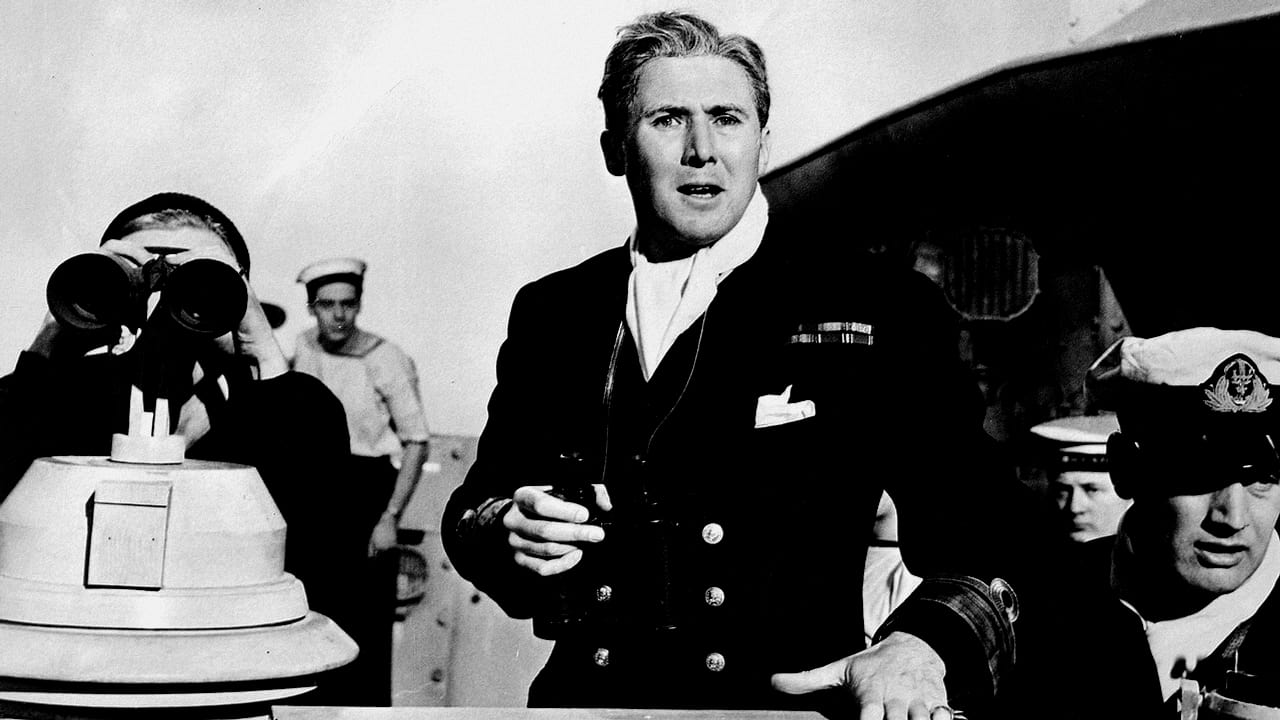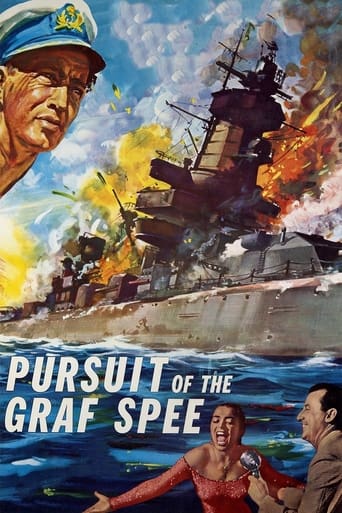

the leading man is my tpye
... View MoreWhat makes it different from others?
... View MorePlot so thin, it passes unnoticed.
... View MoreThe film may be flawed, but its message is not.
... View MoreThis is a story about a sea battle and the gallant heroism of both the British Navy and the German Captain Langsdorff. The theme is, while two nations were at war, individuals have much in common. The setting then involves the coastline of Uruguay and its people anticipating an end battle between the two belligerents while intrigue and strategy plays out between British naval attachés and Uruguay government officials. It's not a complete story but it throws light on military bravery away from the distant ugly Nazi ideology.
... View MoreIn the opening months of WWII, the formidable 'pocket battleship' Admiral Graf Spee is raiding commercial shipping in the south Atlantic. The film depicts events before, during, and after an engagement with three Royal Navy cruisers, leading to the eventual sinking of the Graf Spee.The term 'pocket battleship' was coined by the Royal Navy to describe the three 'Deutschland' class cruisers of the Reichsmarine, constructed between 1933 and 1936. These ships were nominally designed within the 10000t limit of the Versailles treaty; however in reality they were all in excess of this. The Graf Spee was the third and heaviest of its class, and is estimated to have been over 16000t at full load.Using innovative design and manufacturing methods, these ships were built to save weight where possible, in order that heavier armament and better armour plating could be carried. The net result was that these 'panzerschiffe' had the displacement of a cruiser, yet carried more armour and had guns that were the match for most battleships with double the displacement.Thus the Graf Spee, with its 11" primary armament, outgunned the Royal Navy squadron significantly; the biggest guns, on the 'Exeter', were similar in quantity but only 8", and had a maximum range some five miles less. The 6" gun secondary armament on the Graf Spee was similarly a match both in quantity and quality for the other two Royal Navy ships.The tactics used were to an extent dictated by the range discrepancy; the Royal Navy had decided to close to their gun's range "as soon as the beast was sighted", in two groups, and thus force a highly dangerous, but hopefully decisive action.Fought at a time when the 'Phoney War' was underway elsewhere, this was the first major naval battle of WWII; and (asides from the use of spotter planes) was fought without the benefit of radar and other modern developments. Arguably it could be regarded as 'the last sea battle of the first World War' both in equipment and tactics.The events of the battle were originally not considered to be a good narrative basis for a film. However the account of Cpt Dove, who was a prisoner on the Graf Spee at the time of the battle, together with the game of diplomatic bluff played out in Montevideo, added enough breadth and interest for Powell and Pressburger to craft their fine film.The film has an excellent cast, some wonderful cinematography of real (and in some cases THE real) ships in the battle, and I found it quite captivating. Presumably restored in recent times, it both looks and sounds fantastic.The events depicted differ little from what actually happened, and give a sympathetic portrayal of Cpt Langsdorff of the Graf Spee, whose conduct was admired on all sides. Later in WWII there was far less scope for gentlemanly behaviour at sea; the tactics of 'total war' lead to enormous losses on all sides.Doubtless if this film was remade by Hollywood today, it would have all kinds of spurious (and highly fictional) sub-plots, perhaps even a different narrative altogether, and instead of real ships and occasional models, it would be chock-full of CGI instead. Call me old-fashioned, but I prefer the former to the latter; if enough CGI is used, you might as well be watching a cartoon....So in my mind this film stands on its merits, not just as a period piece, but in absolute terms. Films of this type and this calibre are simply no longer made, so this is 'must see stuff' for any film enthusiast.
... View MoreA former teacher of mine who had previously served in the navy was a fan of this film and made a passionate speech once in school about the underlying themes of the film which was about understanding and respecting your enemies.The admirable filmmaking partnership Michael Powell and Emeric Pressburger turn their attention to The Battle of the River Plate 10 years after the end of the second world war with an entertaining reconstruction of three smaller warships against the German Pocket Battleship 'Graf Spee' skippered by a seemingly honourable Captain Langsdorf (Peter Finch) although in opening scenes it looks like the Graf Spee has sunk a British vessel inside Portuguese territorial waters.There is a lot of cat and mouse as the British commanders anticipate Langsdorf's next moves, in between the lull you have diplomatic manoeuvrings between the Allies and Nazis against the Uruguayan government. In the climax you have a live American broadcast from a cafe/bar in the harbour with Christopher Lee playing a South American bar owner.Powell and Pressburger shy away from the jingoism and histrionics that plagued a lot of post war films, I guess they did their bit for the war effort during the war itself with films like Colonel Blimp and as always were ahead of their time even when making a post war film looking back at the start of the war.There is little about the personal lives of the seamen, we do not see them reminiscing about the loved ones waiting for them back home. Its all about strategy and getting the job done with a few scenes of comic relief.The film is very well photographed and they had the cooperation of the Royal Navy that supplied naval ships for the film. However they could had done with some model work as their were some jarring scenes with the studio shots that do not stand up too well these days.
... View MoreI very often will read a book first to learn a deeper level of knowledge about a historical event. Before watching this film I read "The Battle of the River Plate" by Dudley Pope (circa 1956) - paperback. I really liked that book as it provides loads of information about the Graf Spe, a German "pocket" battle ship, which was brand new at the outset of WW2 and for its time and size, cutting edge and fearsome. I recommend viewers to that book.The movie was quite enjoyable as an action adventure / historical drama. My version of the film had "extras" including interviews with Christopher Lee and others. We learn that the directors had to capture long distance shots of US Navy boats whenever they could, which was often last minute. In any case, the story is fairly well covered. I have to admit that I am not always a fan of the acting quality of certain eras. I don't want to give the impression that I dislike older films; the exact opposite is usually the case. I am trying to bring out a point and that is often set pieces like this film, done in studios and not on location, like this one, the actors sadly take on a very mannered, somewhat brittle and stiff physicality to their "acting". And this film had such a fine collection of terrific actors, who aged well into their craft as they grew older. Look at Christopher Lee, who has a tiny role in this film, whip thin, you can hardly recognize him. Most of the lead actors were incredibly slim (not that it really matters). I find early Michael Redgrave films troublesome because I find his approach too self conscious and remote. Seeing him as Master and Commander of his small scale and somewhat suicidal fleet, hunting down a far superior ship, chomping away on his pipe, it's a bit too much. I suppose that people actually behaved this way but I find it grating on my nerves.I often compare one film against another and for me one of the top films of the sea, not yet eclipsed, is "Das Boot". Imagine the Graf Spee story as told by Wofgang Petersen? You'd have an anti-romantic, blood and guts story, with the battle see sawing back and forth, no one really knowing who was winning. That was the truth of the matter; the Brits did not know how much damage they were causing and the reason was not a lack of radar. It was because these ships were lobbing shells at each other from many miles separation! The Graf Spee's biggest guns could lob shells so far that it took almost a full 60 seconds for them to hit their target from the moment they were shot out of the cannons.The dialogue was not overly impressive and the loss of life and damage of the Exeter was underplayed: they had the crap smashed out of them and were almost sunk.The Graf Spee was the first ship in history to be outfitted with functional, if weak, radar. The Brits sent up sighter sea planes who could radio sightings back to the ship. Minus radar, the optical sighting of the crew was limited to the strength of small telescopes and hand held binoculars. This was early in the war. The scuttling of the Graf Spee is still discussed today because it seems such a mystery. Although his ship did take a fair amount of damage and his cooking areas (galley) were destroyed, Langsdorf still had the use of his superior guns. Why did he scuttle the ship? We still are not sure but the defeat and scuttling must have really shocked the German Naval Command.Other than somewhat wooden acting and commanders who didn't seem all that worried that shells were hitting the waters just a few feet away from blowing huge holes in their own ships, it's a pretty good film. I think Petersen should remake this film from the German point of view. Now that is something exciting to contemplate.
... View More